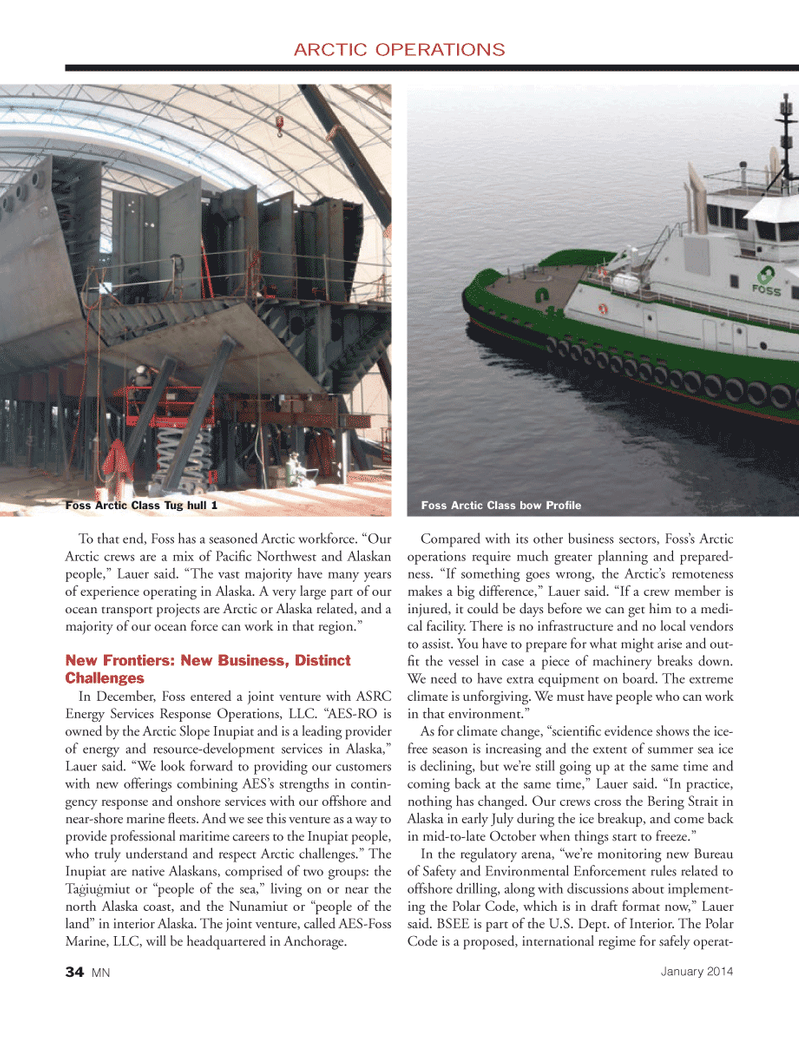
Page 34: of Marine News Magazine (January 2014)
Tug Boat Technology
Read this page in Pdf, Flash or Html5 edition of January 2014 Marine News Magazine
To that end, Foss has a seasoned Arctic workforce. “Our
Arctic crews are a mix of Pacifi c Northwest and Alaskan people,” Lauer said. “The vast majority have many years of experience operating in Alaska. A very large part of our ocean transport projects are Arctic or Alaska related, and a majority of our ocean force can work in that region.”
New Frontiers: New Business, Distinct
Challenges
In December, Foss entered a joint venture with ASRC
Energy Services Response Operations, LLC. “AES-RO is owned by the Arctic Slope Inupiat and is a leading provider of energy and resource-development services in Alaska,”
Lauer said. “We look forward to providing our customers with new offerings combining AES’s strengths in contin- gency response and onshore services with our offshore and near-shore marine fl eets. And we see this venture as a way to provide professional maritime careers to the Inupiat people, who truly understand and respect Arctic challenges.” The
Inupiat are native Alaskans, comprised of two groups: the
Tagiugmiut or “people of the sea,” living on or near the north Alaska coast, and the Nunamiut or “people of the land” in interior Alaska. The joint venture, called AES-Foss
Marine, LLC, will be headquartered in Anchorage.
Compared with its other business sectors, Foss’s Arctic operations require much greater planning and prepared- ness. “If something goes wrong, the Arctic’s remoteness makes a big difference,” Lauer said. “If a crew member is injured, it could be days before we can get him to a medi- cal facility. There is no infrastructure and no local vendors to assist. You have to prepare for what might arise and out- fi t the vessel in case a piece of machinery breaks down.
We need to have extra equipment on board. The extreme climate is unforgiving. We must have people who can work in that environment.”
As for climate change, “scientifi c evidence shows the ice- free season is increasing and the extent of summer sea ice is declining, but we’re still going up at the same time and coming back at the same time,” Lauer said. “In practice, nothing has changed. Our crews cross the Bering Strait in
Alaska in early July during the ice breakup, and come back in mid-to-late October when things start to freeze.”
In the regulatory arena, “we’re monitoring new Bureau of Safety and Environmental Enforcement rules related to offshore drilling, along with discussions about implement- ing the Polar Code, which is in draft format now,” Lauer said. BSEE is part of the U.S. Dept. of Interior. The Polar
Code is a proposed, international regime for safely operat-
ARCTIC OPERATIONS
Foss Arctic Class bow Profi leFoss Arctic Class Tug hull 1
January 2014 34 MN
MN JAN14 Layout 32-49.indd 34 12/20/2013 10:12:11 AM

 33
33

 35
35
